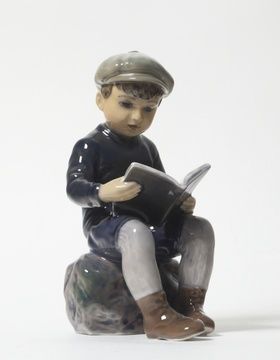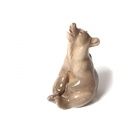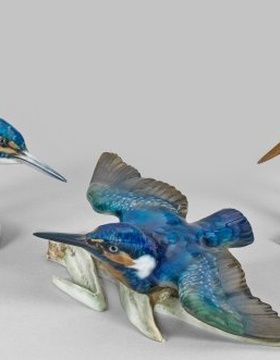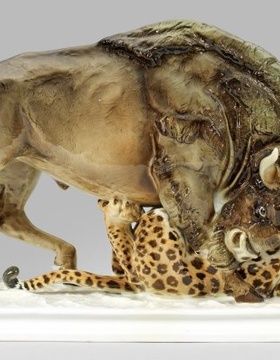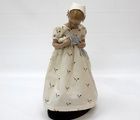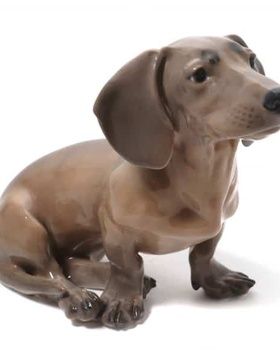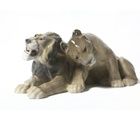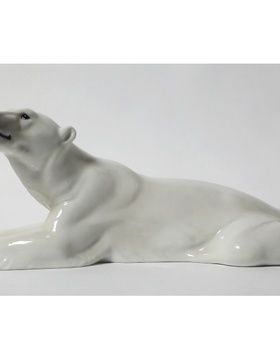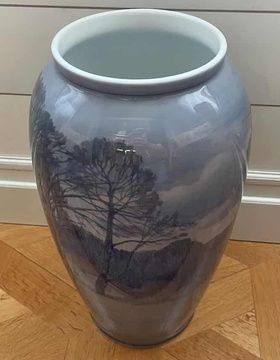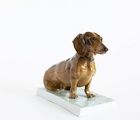
Фабрика Bing & Grondahl была основана в 1853 году в Копенгагене, Дания, Кристианом Шонбергом Бингом и Йоханом Фрадериком Грондалем. Они начали производить фарфоровую посуду и фигурки, используя традиционные технологии, но с уникальным дизайном.
В 1868 году фабрика переехала на новое место, где были построены новые здания и установлены новые оборудования для производства фарфора. Фабрика стала одним из крупнейших производителей фарфоровой посуды в Дании и скоро стала известной за пределами страны.
Одной из особенностей фабрики Bing & Grondahl является использование глазури кобальтового синего цвета, которая стала одной из характерных черт производимой посуды. Кроме того, фабрика Bing & Grondahl также производила фигурки из фарфора, которые были художественно выполнены и украшены вручную.
В 1895 году фабрика Bing & Grondahl приобрела другую датскую фабрику фарфора, Роял Копенгаген (Royal Copenhagen), что привело к созданию новой компании Royal Copenhagen-Bing & Grondahl. Однако, несмотря на слияние, фабрики продолжали работать отдельно и сохраняли свои уникальные черты и стили.
Сегодня фабрика Bing & Grondahl продолжает производить фарфоровую посуду и фигурки, используя традиционные технологии и дизайн. Ее продукция является одной из самых известных и качественных в Дании и по всему миру. Некоторые из фигурок, созданных в фабрике Bing & Grondahl, считаются настоящими произведениями искусства и украшают музеи и частные коллекции.
Статуэтки фабрики Bing & Grondahl
Статуэтки фабрики Bing & Grondahl являются одними из наиболее известных и желанных среди коллекционеров. Это связано с их высоким качеством, уникальным дизайном и техникой изготовления.
Каждая статуэтка создается вручную и проходит несколько этапов производства. Сначала скульптор создает модель из глины или воска, которая затем используется для создания формы из гипса. Затем форма используется для создания статуэтки из фарфора, который выдерживается при высокой температуре, чтобы получить нужную прочность и цвет.
Дизайн статуэток Bing & Grondahl часто является уникальным и отличается от других фарфоровых статуэток. Фабрика известна своими узнаваемыми и красивыми мотивами, такими как птицы, животные, девушки в костюмах и т.д.
Одной из особенностей статуэток Bing & Grondahl является их тонкий и элегантный дизайн, который делает их идеальными для декорирования интерьера. Они могут быть использованы как отдельные предметы, так и в составе коллекции.
Кроме того, фабрика Bing & Grondahl производит статуэтки, которые являются частью серий, посвященных различным темам, таким как сказки Ганса Христиана Андерсена или исторические персонажи. Это делает коллекционирование статуэток Bing & Grondahl еще более интересным и разнообразным.
Некоторые из статуэток Bing & Grondahl, созданных в прошлом, сегодня являются настоящими коллекционными раритетами, их цена может достигать значительных сумм на аукционах и в антикварных магазинах.
Раритетные статуэтки фабрики Bing & Grondahl
Статуэтки фабрики Bing & Grondahl считаются довольно ценными, но самые дорогие и редкие из них - это эксклюзивные модели, выпущенные в ограниченном количестве. Одним из наиболее ценных и редких изделий является статуэтка "Три кита", которая была выпущена в 1895 году всего в 10 экземплярах. Сейчас эти статуэтки считаются очень редкими и дорогими. В 2016 году на аукционе Sotheby's статуэтка "Три кита" была продана за сумму в $33,000.
Другой редкой и дорогой статуэткой является "Медведь и два медвежонка", которая была выпущена в 1915 году и продана на аукционе за более чем $11,000. Также стоит упомянуть о статуэтке "Девушка в красном", которая была выпущена в 1937 году и была продана на аукционе в 2013 году за $6,500.
Кроме того, статуэтки, созданные известными художниками, такими как Кай Нильсен и Jeanne Grut, также считаются очень ценными и дорогими. Например, статуэтка "Женщина в белом платье", созданная Кай Нильсеном в 1909 году, была продана на аукционе за $2,800.
Также стоит отметить, что старые модели статуэток, выпущенные в конце 19-го и начале 20-го века, в целом являются более ценными, чем более новые модели. Например, статуэтка "Садовник", выпущенная в 1898 году, может стоить от $2,000 до $5,000, в зависимости от состояния и редкости экземпляра.
Известные скульпторы художники работали в Bing & Grondahl
Многие известные скульпторы и художники работали в Bing & Grondahl. Некоторые из них:
Эрик Нильсен (1876-1948) - датский скульптор, который начал работать в Bing & Grondahl в 1909 году. Он создал множество изящных статуэток, включая "Девушку на лавочке" и "Китайскую девушку".
Харальд Слотт-Мёллер (1864-1937) - датский художник и дизайнер, работавший в Bing & Grondahl в конце 19-го и начале 20-го веков. Он известен своими декоративными узорами и орнаментами, которые он создавал для фарфоровых изделий, включая статуэтки.
Кристиан Томсен (1853-1927) - датский художник, работавший в Bing & Grondahl в конце 19-го века. Он известен своими реалистическими и живописными портретами, а также работами в жанре исторической живописи.
Вильгельм Хансен (1868-1936) - датский скульптор, работавший в Bing & Grondahl в начале 20-го века. Он создал множество изящных статуэток, включая "Девушку с птицей" и "Девушку с оленем".
Херман Каалунд (1839-1909) - датский художник, работавший в Bing & Grondahl в конце 19-го века. Он известен своими реалистическими и живописными портретами, а также работами в жанре исторической живописи.
Эти и другие талантливые художники и скульпторы внесли значительный вклад в историю фабрики Bing & Grondahl и помогли создать ее уникальный стиль и изысканный дизайн.
